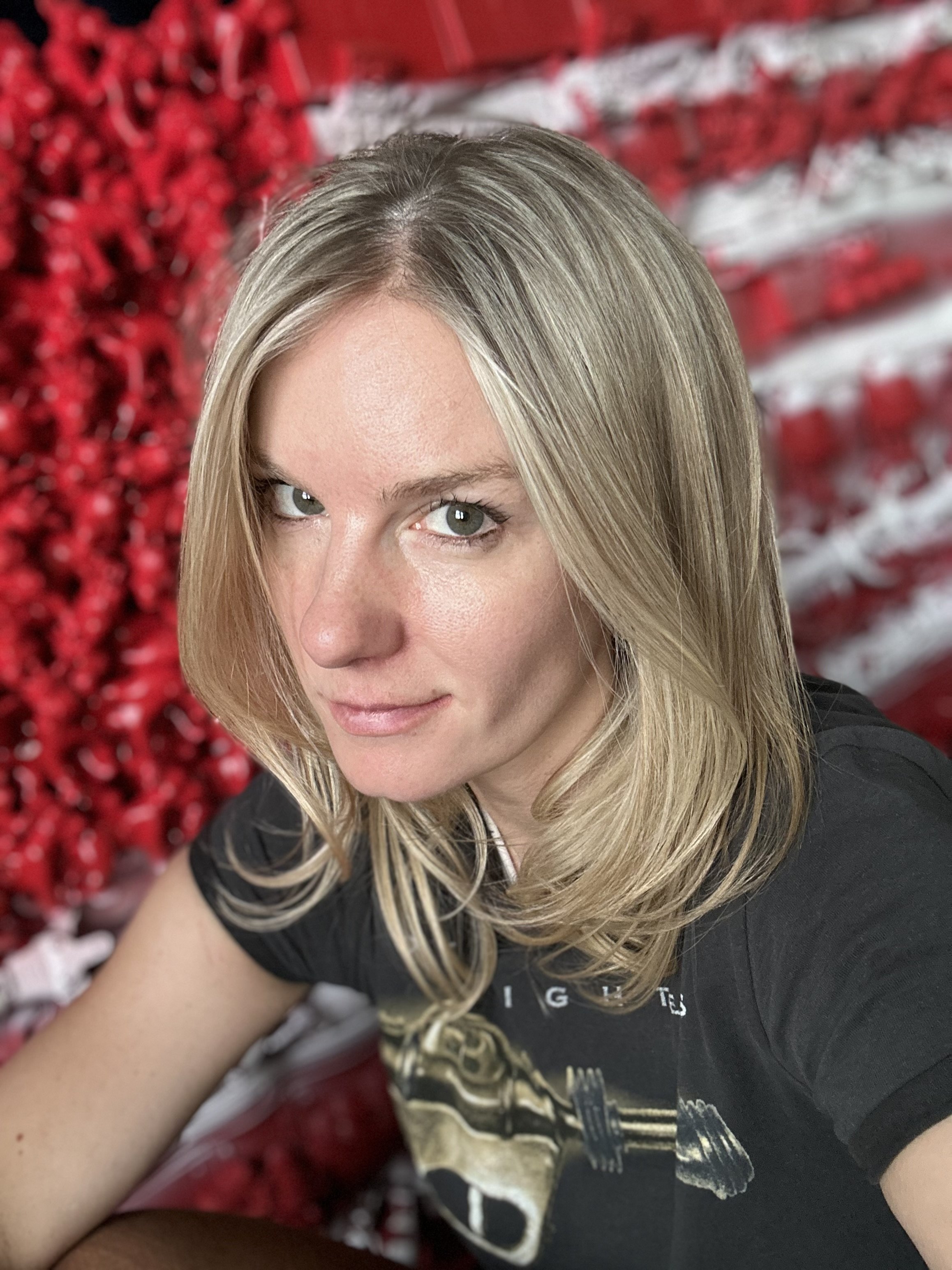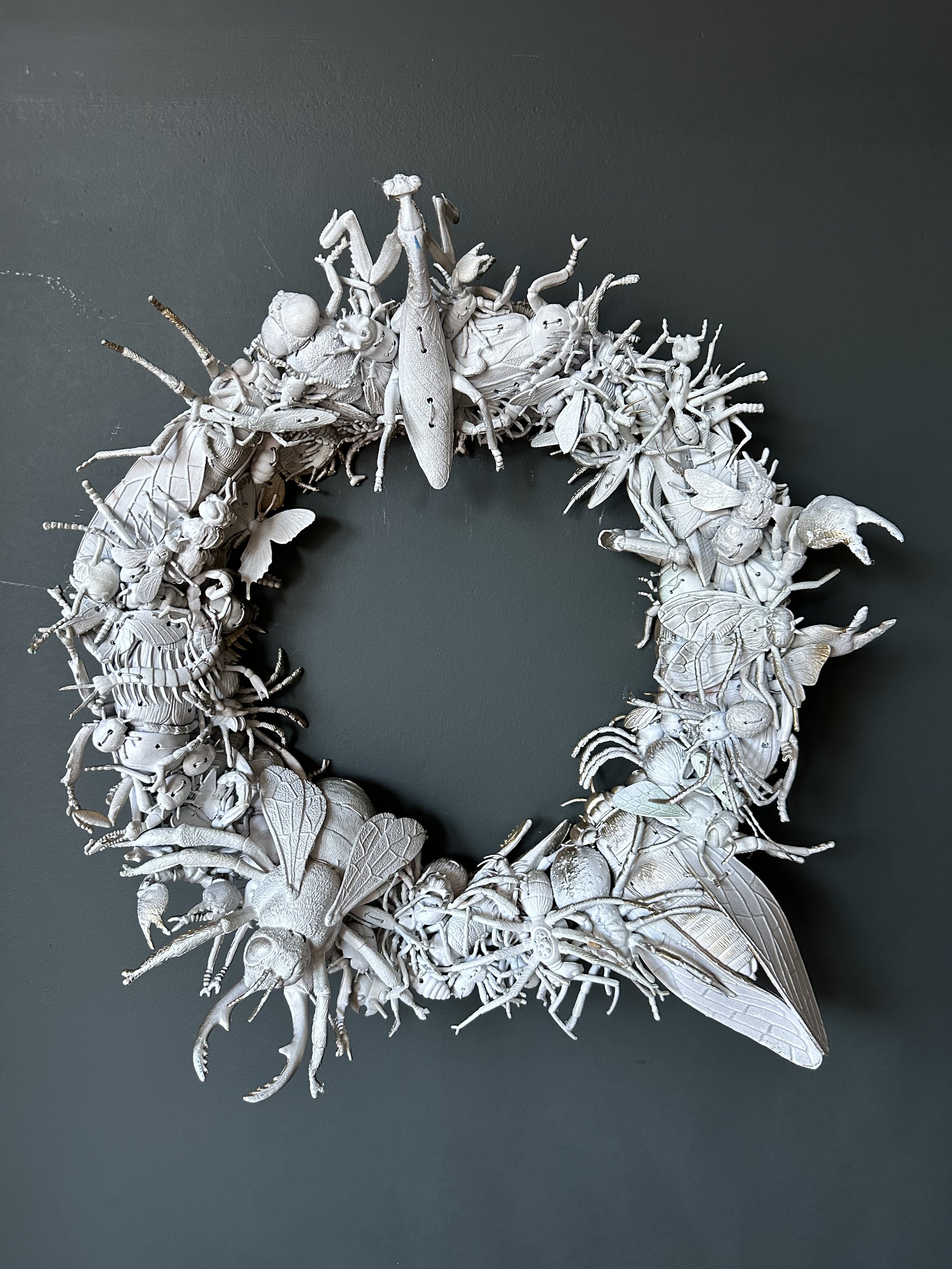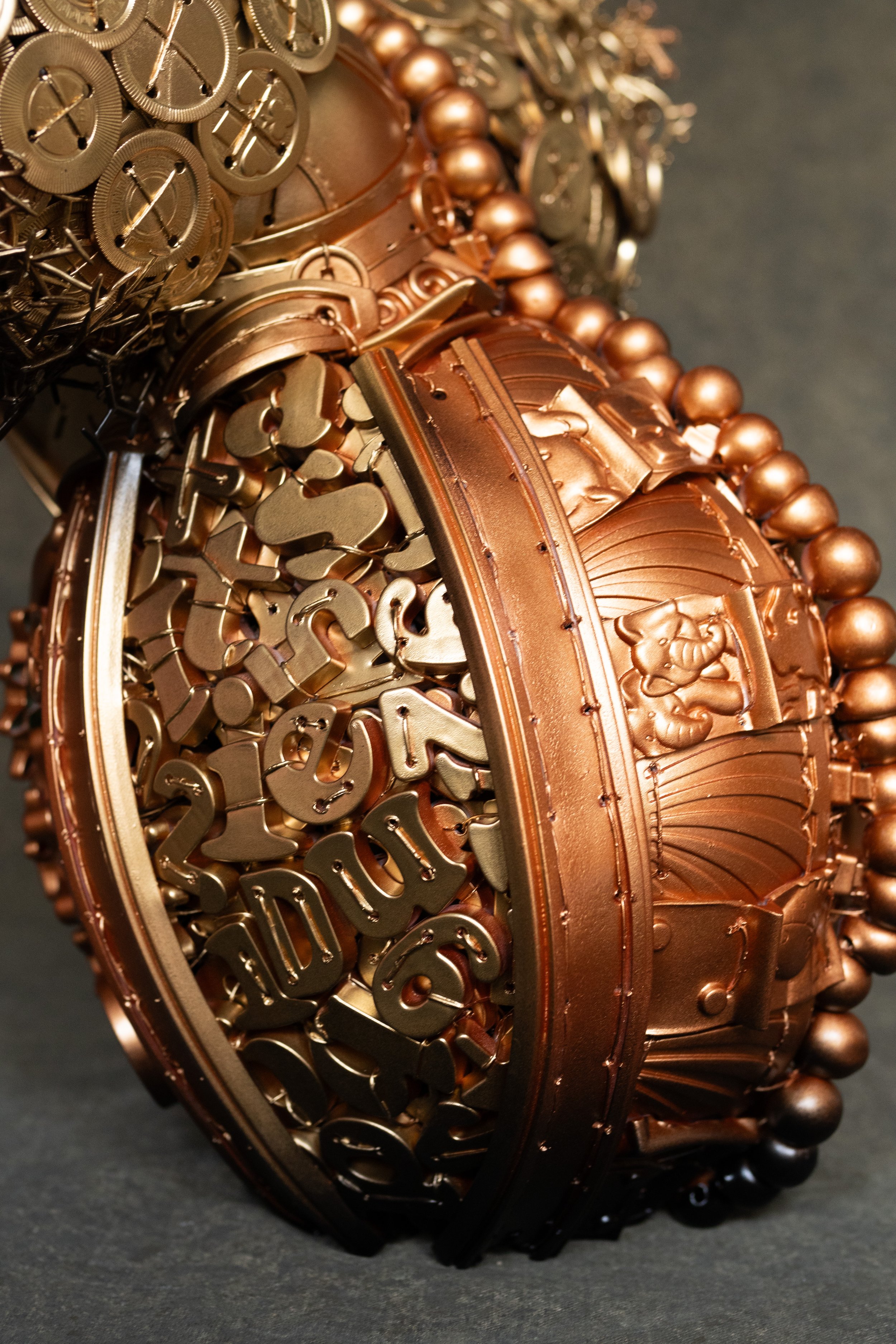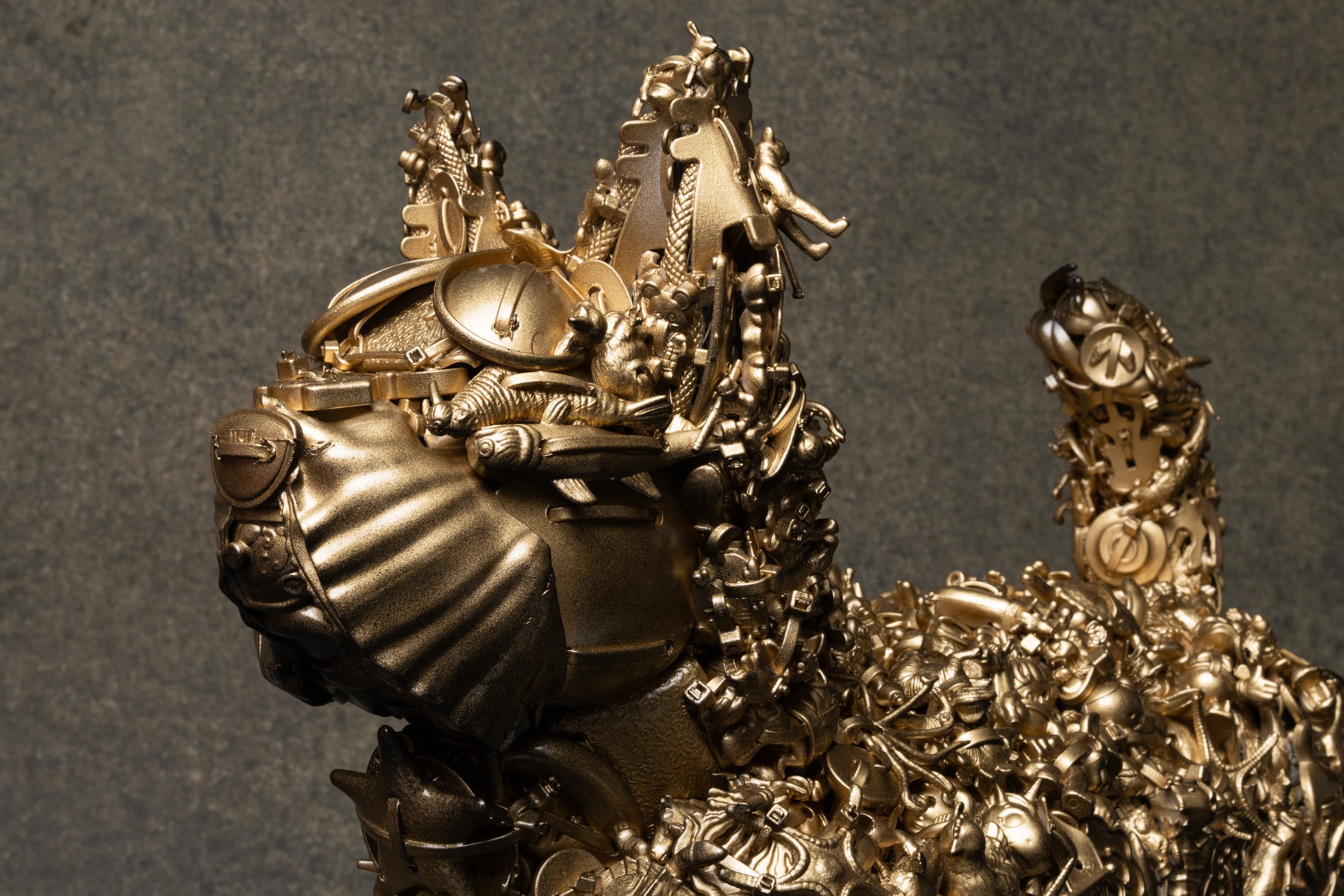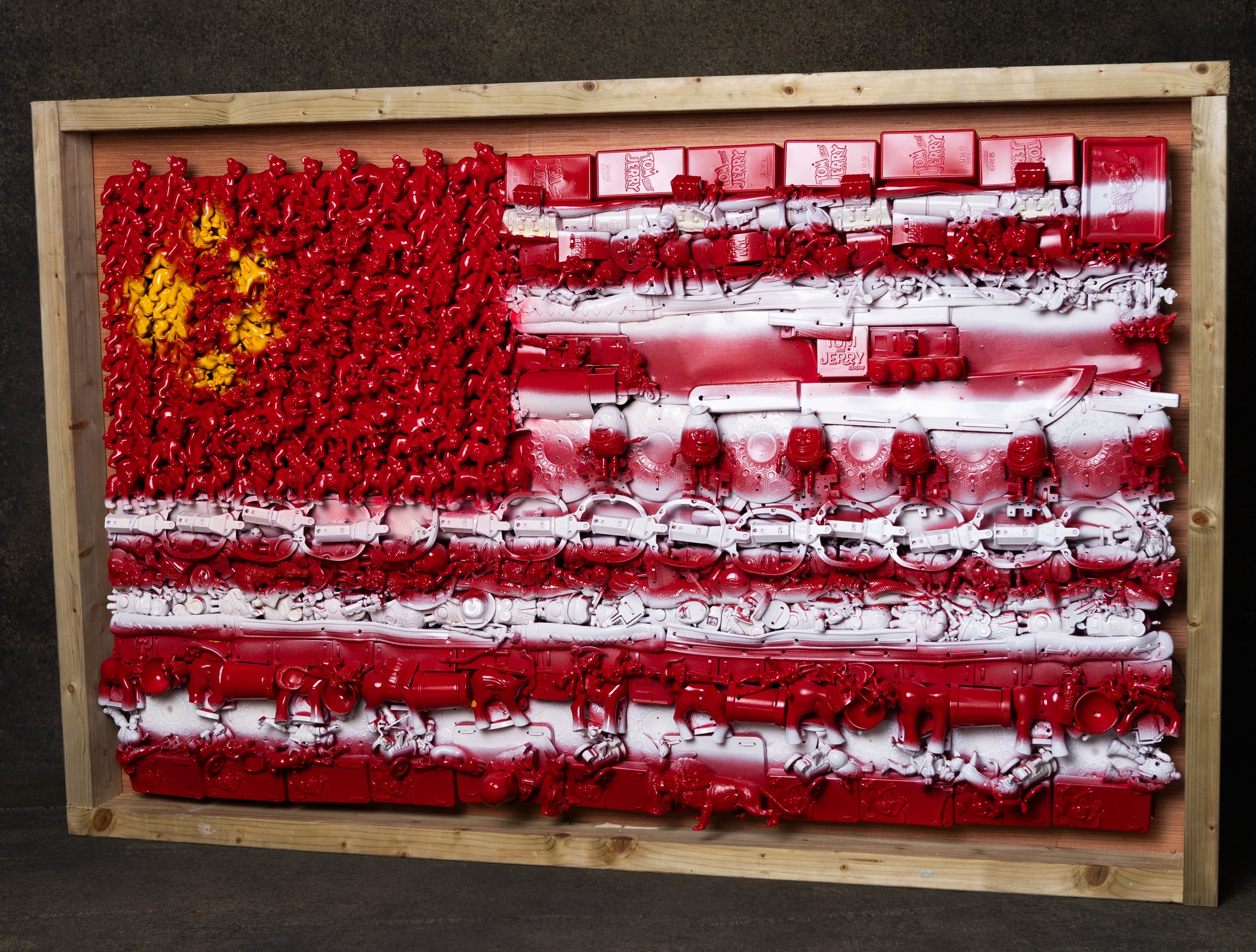Interview
Rye
Rye is an American artist who has lived in Paris, Zurich and London. She considers plastic to be nature's own "natural element" and her sculptures and pieces are made entirely out of old plastic toys. Her contemporary taxidermy seeks to take the viewer on a surprising nostalgic journey as they first identify one or two toys within the piece and then stop to have a closer look. The relationship between individual and moral obligation is brought to a head with her pieces by evoking childhood memories of beloved toys into the forefront of the planet's plastic crisis.
What is your background and how did you start your journey in the art world?
“I am originally from Seattle but I have spent most of my adult life living abroad - first in Paris, then Zurich and finally settling in London in 2012. I have always created things, ever since I can remember so in terms of being an artist, I can't remember not being one. However, with regards to my current artwork I first moved into this medium as a hobby in 2020 during the pandemic. Over time this organically grew and for the past year I have dedicated 8 hours a day strictly to my sculptures, which has been an incredible experience. I have a studio in Forest Gate, East London, where I am surrounded by creatives doing their own thing and it keeps me inspired everyday, as much of my sculpting is done in solitude. My pieces began as wall art - my wreath series - but this evolved over time and led to the 3D animals and wall pieces on a much larger scale. I gave myself a year to finish the animal series for the debut of my contemporary taxidermy and I still have several to finish but I'm aiming to finish them by September. Here's hoping I make that goal, which I feel pretty confident will work out ok. It's not always easy to know how long a piece will take - there can be a lot of variance - but I'm there everyday, getting absolutely lost in each animal as they begin to take shape. As they've been coming together I've gained more confidence and that led to my decision to start looking outward. I started submitting to open calls in an effort to face the fear of rejection and put myself out there as an artist - to really embrace that identity. It's an interesting experience, to put these pieces of your heart and soul out into the great void and see what comes back to you. I am so emotionally attached to each piece that it's been a wonderful experience to see some of them get a moment to resonate with other people. It's like sharing a piece of my heart with the world and watching when and where they speak with strangers. It's empowering, terrifying and freeing all in one moment.”
What does your work aim to say? Does it comment on any current social or political issues?
“I work exclusively with old plastic toys. I view plastic as humanity's own 'natural element' as we created it, it's here and for the next however many centuries it will be sitting inside the Earth, without degradation. I was first inspired by this idea with the thought of future archaeologists digging into the Earth and finding the exact same toy on repeat millions of times over. I couldn't get this image out of my mind of someone in the future trying to work out why our era thought it was necessary for each child to have so many objects or animals found in the world replicated in miniature plastic versions. Plastic obviously is used everywhere but toys are my focus because in addition to them never breaking down, we as individuals have such a nostalgic and playful tie to them. So, whilst there is an incredible moral obligation for us all to really look at ourselves and ask the hard questions of what, exactly, are we planning on doing with all of this junk. There is also an undeniable emotional attachment we have with these objects. That can come from our own childhoods, our children, even generations before us have memories of specific toys. I remember finding a baby rattle in one of my great charity shop dives and it was one of those moments where the site of it brought me right back to my baby brother - and when I showed it to my mom she remembered it from her baby sister. It's still the same model, sitting there in the charity shop, and we can recognize and acknowledge how much of a problem that is on a large scale while still having these moments of triggered memories. The toys make the plastic more of a grey area than if I were to use, say, milk bottle caps or something that is so totally disposable that it is easier to disassociate yourself with that being relevant to your own identity - but toys cross the line into your psyche and that makes them a far more interesting medium.
It is harder to ignore the problem of the grotesque waste generated by these temporary toys when you remember the joy some of them have brought you, entangled into your own childhood memories. I also have a piece, Achilles, which is a hybrid of the American and Chinese flags. It's made entirely from fast food chain toys - over 700 - and it is definitely a reflection of this hybrid between the nation that mass produces at an alarming rate and the nation that grotesquely consumes. I read somewhere that a child only plays with a plastic toy from a fast food chain - on average - 48 hours and then they are bored or over it entirely. Yet, the quantity of waste generated from these types of things is absolutely phenomenal. So, in this sense I am always playing with this idea of beckoning an individual to stop and think about the sheer quantity of these items on the planet.”
Do you plan your work in advance, or is it improvisation?
“A lot of my pieces are planned in advance but that doesn't mean I don't have sections of each one that are more improvised than others. In some of my animals the toys used are more random - a sporadic collection of them tangled together to shape various limbs or body parts. In other cases there are animals where specific body sections begged me for very specific toys and so I set about scouting what I needed specifically for these sections. An example of this is a turtle, Chelone - who has an underbelly made entirely from old dominos. I knew I needed that texture on that specific party of her, in contrast to the small animal figurines that create her shell to give it the rougher, jagged edges I was after. Her limbs and head were created entirely from the foliage pieces of an old play castle - it took a long time to find the right type of toy to capture that leathery look I really wanted for that section. In the end she took longer because she was meticulously planned out. Another animal I have completed is an owl. Initially I wasn't sure how he would come together but I happened to continuously find the right piece for each body part to capture smooth versus rougher feathers and that was really fun. I laughed a lot as I assembled him and his pieces weren't planned so much as delightfully found in my boxes of stored toys. So, there is an element of both planning and spontaneous nonsense that happens in my studio. It's hard not to laugh when you're working with toys all day - and that playfulness is something I embrace in my own identity and I really hope that bleeds into my work.”
Are there any art world trends you are following?
“Something that I've noticed becoming more prevalent in London and other cities are the various immersive art experiences. I've visited the Van Gogh, Frida, Dali, Hockney experiences and there is something really beautiful about this idea of taking these very famous pieces and deconstructing them into a medium that is more accessible to an everyday audience. You aren't required to have a deep understanding or knowledge of art or of these famous pieces before going into these shows and yet here they are, completely captivating new and younger audiences with the same imagery but with a completely contemporary execution. As Marshall McLuhan famously wrote, the medium is the massage and nothing highlights this more for me than this idea that new audiences are still discovering and appreciating these artists - and new audiences who wouldn't necessarily want to go into a more traditional museum, wear a headset and shuffle through. It's reshaping the experience to speak a language that young people today speak - and this communication is bridging an obvious gap between tradition and our new digital era. The message is being received on a greater scale to the younger generations because the manner of communicating it is evolving.”
“Each piece I create has a little piece of me in it. I couldn't dedicate this much time and effort to something that I didn't feel this passionate about.”
What process, materials and techniques do you use to create your artwork?
“My technique varies of course, with the type of contemporary taxidermy I'm working on. With the wreath series, for example, they each have a very specific themed type of toy on them. Unleash the Underworld was created using old plastic insects. I'd had this dream about a bunch of fly ghosts rising from the husks of their tiny dead bodies in a windowsill and circling around before finally making their way out of the window, free from their creepy bodies. It really stuck with me and so I knew I wanted to find loads of old insects to play around with for this piece. I ended up scouting the three largest bugs first and the rest were slowly tangled around to keep that symmetry in the spacing between the larger insects. I also have a seemingly endless supply of old fast food chain toys, I get brought bags of old and broken toys from my community and I tend to look at what I have to determine where to go next. I have a series of larger wall graffiti pieces that are set to release next year and this idea was in direct response to the amount of larger play sets and pieces that people bring me. They require a larger space as the toys are so much bigger and so I played around with how best to tackle those.
Then of course, I have tiny pieces as well that are always needed for the top layers. All of my pieces are incredibly layered so there are endless toys to identify hidden amongst others. Some shapes I like to keep for the top layers as they are so easily recognizable - an example of this would be a Mickey Mouse figurine as that head with those ears is usually a great way to get someone to do a double take and hopefully capture their interest a bit to take a closer look. Layering the toys takes an incredible amount of time but I get there in the end. There are also techniques required for the animal sculptures - such as starting at the ends as it gets harder and harder to fit your hand deep inside the pieces with each layer underneath. My hands have definitely suffered in this process and I am forever trying to find new solutions to that issue but I always just end up with bare hands again because I don't like anything getting in my way. In terms of the actual activity of sculpting itself - once I have the toys decided and laid out on my worktable I tend to listen to music or podcasts and sort of go into a deep trance as I'm working. I don't really notice time passing, I don't check my phone, it's just me and the piece, getting to know one another as it starts to reveal itself to me the further along we get.”
What does your art mean to you?
“Each piece I create has a little piece of me in it. I couldn't dedicate this much time and effort to something that I didn't feel this passionate about. The animals in particular really speak to me because the more of my heart I put into them during assembly, the more they sort of come alive to me as they really begin to take shape. I remember taking a long time to decide what to do with the dog sculpture, Philia's, jowls. There was a lot of trial and error in the process and I kept taking things back off again and just staring at this frame and wondering what was missing. Finally, I found some rubber princess dresses in my studio and I realized that if I cut them just right, I could flay them out and get the exact look I was after for this particular part of her face. When I got her assembled together with them I just stared at her and smiled - they become my weird little friends as I spend so much time and effort with them. I also feel this way about the wall pieces. One of the first wreaths I did was one called "Let Them Eat Cake" - made entirely from plastic food and toy tea sets. This one really had a lot of me in it because it was during lockdown and I felt like every time I turned around someone on Zoom was telling me how to make bread or cake and I myself started baking tons of cookies - I suppose in an effort to stay sane - and so when I see that piece now I am immediately brought right back to that time. I have spent much of my life dabbling in various other mediums but I knew when I found this particular method that I was on the right track and so I truly feel that my art has granted me a freedom. The freedom to be my authentic self and when I see any of my pieces I really feel that sense of identity, emotion and playfulness.”
What’s your favourite artwork and why?
“This is such a hard question because so much of viewing art depends on how you are feeling in the moment. It's a dialogue between object and viewer that isn't static and it's this fluid nature that really makes each viewing unique. Overall I am absolutely drawn to much older eras, particularly with sculpture. The manner in which Bernini bent marble to his will - the first time I laid eyes on The Rape of Proserpina it took my breath away. I live for this type of dialogue between ourselves and the masters of the past. It's been centuries and here we are, standing in jeans and trainers completely falling in love with sheer talent. I have a similar relationship with oil paintings. I have fallen in love with too many of them to count but I spent a considerable amount of time soaking up Gericault's Raft of the Medusa the first time I passed her in the Louvre. It's this moment I go into where I feel like somehow, despite the centuries passing, the artist is still here with us each time new eyes really stop to take in the sheer beauty in these pieces.
That's not to suggest I don't also love contemporary art. I recently stumbled across an exhibit from a London-based artist, Day-Z and I fell in love with her pieces as well. I love her use of the Little Tyke car as symbolism for this lost innocence. It's such an immediately identifiable object and I was very drawn to that. Another piece of hers that I love is this sketch of a playboy bunny, with an actual bunny head. Her play with iconic and this sort of brutal, animalistic sexuality really spoke to me as well. I also just love stumbling into galleries to see what's happening. London is pretty amazing in this regard, I also recently discovered another artist called What's His Name and again here is an artist playing with this notion of childhood but in a darker way. His art, particularly the piece with the shadows of Snoopy and Charlie Brown, looking like they're just on the other side of a ghostly veil...that really stuck with me. It's this bereavement of childhood and play and the way in which their hands are both reaching against the veil, like they're trying to grab you but you're just out of reach made me instantly think of the grief associated with losing our innocence, our ability to play and live in that state of childhood wonder.”
Have you had any noteworthy exhibitions you'd like to share?
“I've just had my first exhibit where Philia was shown at The Holy Gallery in Dalston, which I was very honoured and excited to be a part of. My second known exhibit at this point is in Tokyo, where my piece Unleash the Underworld will go on exhibit in November - again I am beyond honoured and grateful for these opportunities. I will keep submitting to other galleries and open calls and I'm just grateful to have the ability to focus on my pieces each and every day.”
Instagram: @rye.artiste

